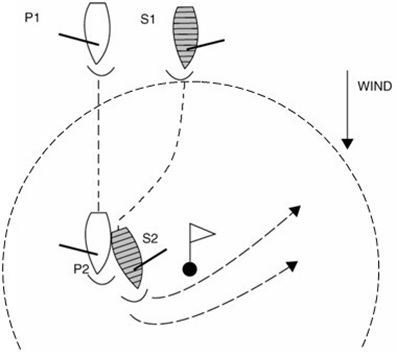



CASE 75
Definitions, Proper Course
Rule 10, On Opposite Tacks
Rule 14, Avoiding Contact
Rule 16.1, Changing Course
Rule 18.2(b), Mark-Room: Giving Mark-Room
Rule 18.4, Mark-Room: Gybing
When rule 18 applies, the rules of Sections A and B apply as
well. When an inside overlapped right-of-way boat must
gybe at a mark, she is entitled to sail her proper course until
she gybes. A starboard-tack boat that changes course does
not break rule 16.1 if she gives a port-tack boat adequate
space to keep clear and the port-tack boat fails to take
advantage of it promptly.
Facts
Two boats, S and P, were sailing directly downwind towards a leeward mark
to be left to port. They had been overlapped for several lengths with S inside
and slightly ahead. As S entered the zone, she luffed. As her bow came
abreast of the mark she bore away to gybe, and there was contact, but no
damage or injury. S protested P under rule 10 while P protested S under rule
18.
The protest committee disqualified P for breaking rule 10. P appealed,
asserting that she had given S mark-room and that S had broken rule 18.4.

Decision
At position 1, S reached the zone and P was required by rule 18.2(b) to give
S mark-room thereafter. In addition, until S gybed P was required by rule
10 to keep clear of S. As S luffed, she was required by rule 16.1 to give P
room to keep clear, and until she gybed S was also required by rule 18.4 to
sail no farther from the mark than needed to sail her proper course. The
mark-room that P was required to give S was the space S needed in the
existing conditions to sail promptly to the mark in a seamanlike way. That
space was a direct corridor from S1 to a position close to and alongside the
mark on the required side. P gave S that room. However, because S had right
of way she was not required to remain within that corridor; she was
permitted to sail any course provided that she complied with rules 16.1 and
18.4.
S luffed gradually through approximately 45 degrees while sailing about
three lengths forward, and P made no effort to keep clear. Shortly before
position 2, S needed to act to avoid P. At that moment P broke rule 10. When
S luffed after position 1, if P had acted promptly there was space for her to
have manoeuvred in a seamanlike way to keep clear of S. Therefore S did
not break rule 16.1.
When S gybed just after position 2, she had not sailed farther from the mark
than needed to sail her proper course. Indeed, in the absence of P (the boat
‘referred to’ in the definition Proper Course), S’s proper course might well
have been to sail even farther from the mark and higher than she did, so as
to make a smoother, faster rounding and to avoid interference with her wind
by being backwinded or blanketed by other boats ahead. Therefore S did not
break rule 18.4.
Concerning rule 14, both boats broke the rule because there was contact and
it was ‘reasonably possible’ for each of them to avoid it. P is therefore
disqualified under rule 14 as well as rule 10. However, S is exonerated
because she was the right-of-way boat when the contact occurred and there
was no damage or injury (see rule 43.1(c)).
P’s appeal is dismissed. She was properly disqualified, and S did nothing
for which she could be penalized.
USA 1976/195






